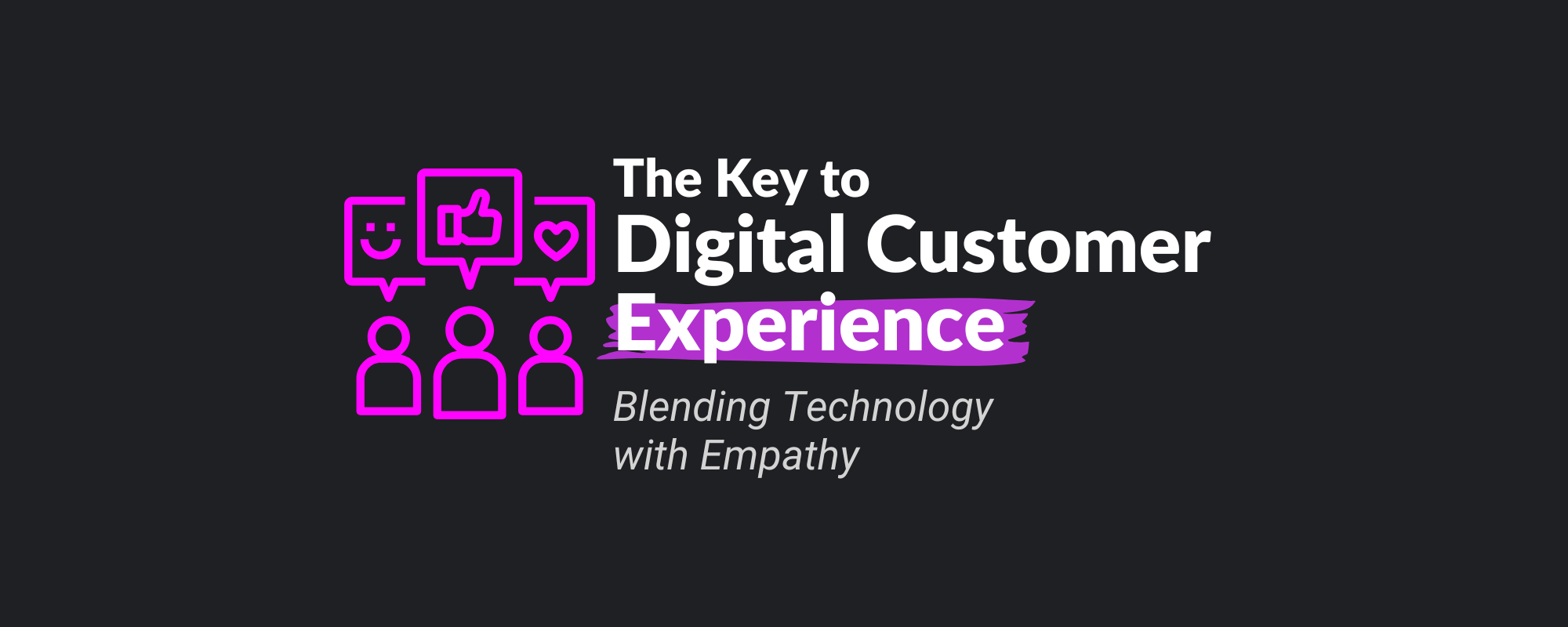The Key to Digital Customer Experience

Imagine walking into your favorite neighborhood store. The shopkeeper knows your name, remembers your last purchase, and even asks how your son is doing in school. This kind of personal touch is what digital experiences aim to replicate in today's tech-driven world—but achieving that level of empathy at scale, through a screen, is no small feat. Especially in a region like the Middle East where cultural expectations and technological sophistication in countries are intertwined, the challenge becomes creating a digital customer experience that feels just as human, warm, and attentive as that shopkeeper's greeting.
In a world increasingly dominated by automation and algorithms, empathy has emerged as a key differentiator. But it's more than a trend. It’s the secret sauce that turns a good customer experience into an unforgettable one. Blending empathy with advanced technologies is the only way to make sure brands stand out—not just for what they offer, but for how they make customers feel.
In this article, I would like to touch on how empathy in digital experiences is not just about customer satisfaction, but about building trust, loyalty, and long-term relationships. We’ll dig into how technology can become the enabler—not the replacement—for genuine human connection.
The Role of Empathy in Digital Customer Experience
In a survey conducted by REDK, 73% of customers expect personalized recognition, yet 56% feel treated impersonally, highlighting the gap that empathy in customer service can address [1]. Empathy in customer service helps build trust and loyalty. When customer service representatives show genuine empathy, customers feel heard and understood.
So, what does empathy mean when we’re talking about customer experience? It means seeing beyond data points and sales funnels and recognizing the human at the other end of the screen. It’s about understanding their pain points, anticipating their needs, and communicating in a way that feels authentic. Empathy is what transforms an indifferent customer into a loyal advocate. It builds trust, and trust, as we know, is at the heart of any lasting relationship.
For instance, brands like Careem have succeeded by integrating empathy into their customer service. Every interaction isn’t just about resolving an issue; it’s also about understanding the customer’s context. In a market like the UAE, where expectations are high and personalization matters deeply, customers notice when a brand takes the time to truly understand them. It becomes more than just a transaction—it’s an emotional connection.
In the digital realm, empathy isn’t about just being nice—it’s about designing experiences that prioritize the customer’s feelings, anticipating where frustrations may arise, and proactively addressing those pain points. Imagine a customer trying to get help with a delayed ride—they don’t just want a refund, they want to be heard, to know that their inconvenience is acknowledged and this is exactly what Careem provides space to. When digital tools are used to communicate in ways that resonate emotionally, they move beyond transactional exchanges and build something much deeper—loyalty.
Technology as an Enabler, Not a Substitute
According to BCG, by 2026, 30% of new apps will use AI for personalized interfaces, up from less than 5% in 2023 [2]. That same BCG survey shows that 67% of CMOs consider using generative AI for better personalization [2]. Furthermore, 71% of consumers expect personalized company interaction, and 76% feel disappointed when it doesn’t happen.
The role of technology in all of this? It’s not to replace the human touch but to scale it. AI and machine learning can help brands understand their customers better—learning patterns, preferences, and predicting needs before they’re even expressed. But it’s the human layer that makes the difference.
Think of AI as the shopkeeper’s assistant—it can remember what you like and suggest something similar, but only the shopkeeper can gauge your mood and recommend just the right item. Personalization tools, AI chatbots, and machine learning algorithms are incredibly powerful, but they must be wielded with empathy to be effective. When AI-driven personalization is paired with a genuine desire to meet customer needs, it can result in a digital experience that feels less like interacting with a machine and more like connecting with someone who actually cares.
Take Souq.com, for example, now part of Amazon. They utilized data analytics to understand buying patterns, but the real value came from using those insights empathetically—anticipating needs and offering solutions rather than just upselling. It’s these kinds of empathetic applications of technology that distinguish a brand from its competitors.
Technology can also enable empathy through the power of predictive analytics. Imagine a customer who frequently buys baby products. Predictive analytics can help identify this trend, and rather than just pushing similar products, the brand can send supportive content about parenting, or even a discount for a much-needed coffee. It’s the subtle acknowledgment of the human behind the behavior that makes the difference.
Human-Centered Design: A Practical Approach
AI personalization tools dig into customer data to craft content that resonates on a more personal level and is aligned with an individual’s specific customer journey with your brand [3]. AI-powered predictive analytics can anticipate customer interests and behaviors based on the data collected, allowing businesses to proactively offer personalized suggestions, offers, experiences, and content.
Human-centered design is about putting the human—your customer—at the core of everything you create. This means not just thinking about what will make a process efficient but also about what will make it delightful. It’s about asking, “How would I feel if I were the customer?” and then designing your systems accordingly.
In the context of digital experiences, this could mean refining an app interface so that even the least tech-savvy person can navigate it easily or ensuring that a chatbot feels conversational rather than mechanical. To implement human-centered design effectively, companies need to be willing to invest in understanding the emotional journeys of their customers.
A practical step is to create customer personas that go beyond demographics and touch on emotional states—how does a person feel when trying to resolve an issue, and what emotional journey do they experience from discovery to purchase? By mapping these emotional experiences, designers can create interfaces that anticipate and mitigate potential points of frustration.
In UAE and KSA, cultural nuances also play a role. Respecting these subtleties in communication—whether through language, tone, or timing—makes a significant impact on how the digital experience is received. Brands that understand and integrate these cultural elements into their human-centered design will naturally create more empathetic and effective customer interactions.
Consider the example of a banking app. Many banking platforms aim to simplify processes like account transfers or bill payments. But what if the design also anticipated customer anxiety, particularly for those unfamiliar with digital banking? Adding clear, conversational prompts, reassuring language, and offering a “call for help” button creates a sense of security. It’s these details that make human-centered design empathetic and user-friendly.
Empathy in Action
Let’s take a closer look at some brands that have successfully blended empathy and technology. Dubai’s Emirates airline excels at incorporating empathy into their customer interactions, even in an industry that’s heavily automated. They leverage technology for convenience—like their seamless app experience and personalized notifications—but they also invest in the human touch. From cabin crew trained to anticipate passenger needs to their follow-up communication, every interaction feels personal and considerate.
In KSA, a newer player like HungerStation has found success by leveraging personalization to create empathetic, localized experiences. They understand that food delivery is as much about convenience as it is about comfort—this is why their communication focuses on delight, from the simple things like friendly order updates to addressing specific customer needs promptly. HungerStation uses technology to understand what their customers want but adds empathetic, human-driven touches to keep them coming back.
These brands understand that empathy isn’t just a nice add-on—it’s a core differentiator that directly impacts customer loyalty and satisfaction. When customers feel valued, they reward brands with their loyalty, and that’s a competitive advantage that no amount of traditional advertising can buy.
Challenges and Blind Spots
Of course, balancing empathy with technology isn’t without its challenges. One common pitfall is leaning too heavily on automation. It’s tempting to automate every aspect of customer interaction to save time and cost, but this can often strip away the human nuance that empathy requires. A chatbot that offers only scripted responses, without the flexibility to understand tone or context, can easily frustrate a customer rather than assist them.
Another challenge is overcoming organizational resistance. Companies must cultivate a culture that values empathy—not just as a buzzword but as a fundamental part of customer interaction. This means training teams to understand empathy and investing in tools that prioritize emotional intelligence as much as operational efficiency.
There’s also the risk of appearing idealistic—suggesting empathy-driven approaches without acknowledging the real-world constraints, like budget limitations or resistance to change. However, the reality is that empathy can start small. It doesn’t have to be a grand overhaul of systems; even minor tweaks in how you handle customer feedback or phrase automated messages can lead to significant improvements.
For instance, instead of a generic “Your request is being processed,” a message that says, “We know waiting can be tough, but we’re working hard to get this sorted for you” makes a difference. It acknowledges the inconvenience and brings a human element into a digital touchpoint.
A Customer-First Approach
The integration of empathy with technology is not just a tactic; it’s a mindset shift. It requires companies to see their customers as individuals with unique emotions and experiences, not just numbers on a sales report. In the digital age, where customer loyalty is increasingly fragile, empathy can be the glue that keeps customers coming back.
Blending technology with empathy helps create digital experiences that are not only efficient but also human, warm, and relatable. In a region like UAE and KSA, where cultural expectations are deeply woven into the fabric of everyday interactions, the companies that stand out are the ones that make their customers feel truly seen and heard.
So, the next time you think about upgrading your digital tools, ask yourself—how does this make my customer feel? Because at the end of the day, it’s not just about the data you collect, but about the connections you create. Empathy, when paired with the right technology, transforms interactions into lasting relationships—and that’s the key to standing out in today’s digital landscape.



Discussion